2010 HYUNDAI TUCSON key
[x] Cancel search: keyPage 204 of 382
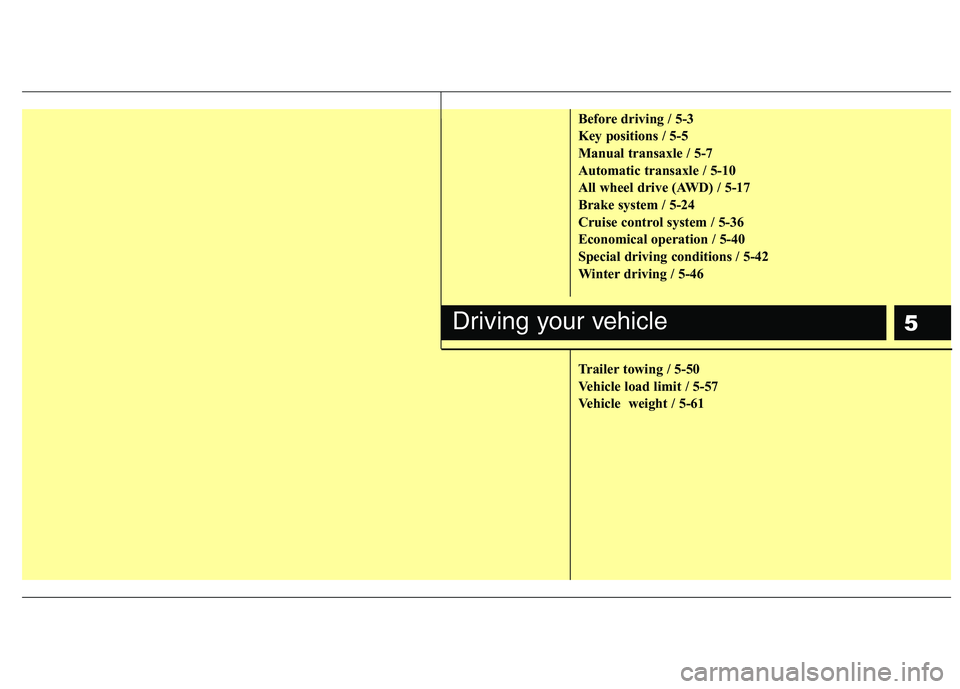
5
Before driving / 5-3
Key positions / 5-5
Manual transaxle / 5-7
Automatic transaxle / 5-10
All wheel drive (AWD) / 5-17
Brake system / 5-24
Cruise control system / 5-36
Economical operation / 5-40
Special driving conditions / 5-42
Winter driving / 5-46
Trailer towing / 5-50
Vehicle load limit / 5-57
Vehicle weight / 5-61
Driving your vehicle
Page 208 of 382
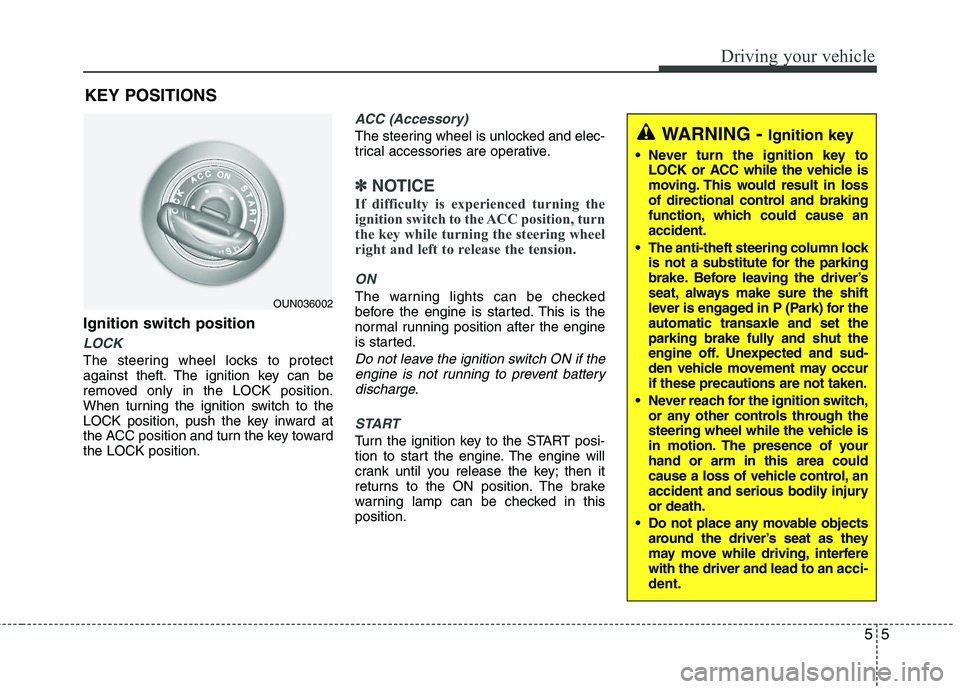
55
Driving your vehicle
Ignition switch position
LOCK
The steering wheel locks to protect
against theft. The ignition key can be
removed only in the LOCK position.
When turning the ignition switch to the
LOCK position, push the key inward at
the ACC position and turn the key toward
the LOCK position.
ACC (Accessory)
The steering wheel is unlocked and elec-
trical accessories are operative.
✽ ✽NOTICE
If difficulty is experienced turning the
ignition switch to the ACC position, turn
the key while turning the steering wheel
right and left to release the tension.
ON
The warning lights can be checked
before the engine is started. This is the
normal running position after the engine
is started.
Do not leave the ignition switch ON if the
engine is not running to prevent batterydischarge.
START
Turn the ignition key to the START posi-
tion to start the engine. The engine will
crank until you release the key; then it
returns to the ON position. The brake
warning lamp can be checked in this
position.
WARNING - Ignition key
Never turn the ignition key to LOCK or ACC while the vehicle is
moving. This would result in loss
of directional control and braking
function, which could cause an
accident.
The anti-theft steering column lock is not a substitute for the parking
brake. Before leaving the driver’s
seat, always make sure the shift
lever is engaged in P (Park) for the
automatic transaxle and set the
parking brake fully and shut the
engine off. Unexpected and sud-
den vehicle movement may occur
if these precautions are not taken.
Never reach for the ignition switch, or any other controls through the
steering wheel while the vehicle is
in motion. The presence of your
hand or arm in this area could
cause a loss of vehicle control, an
accident and serious bodily injury
or death.
Do not place any movable objects around the driver’s seat as they
may move while driving, interfere
with the driver and lead to an acci-
dent.
OUN036002
KEY POSITIONS
Page 209 of 382
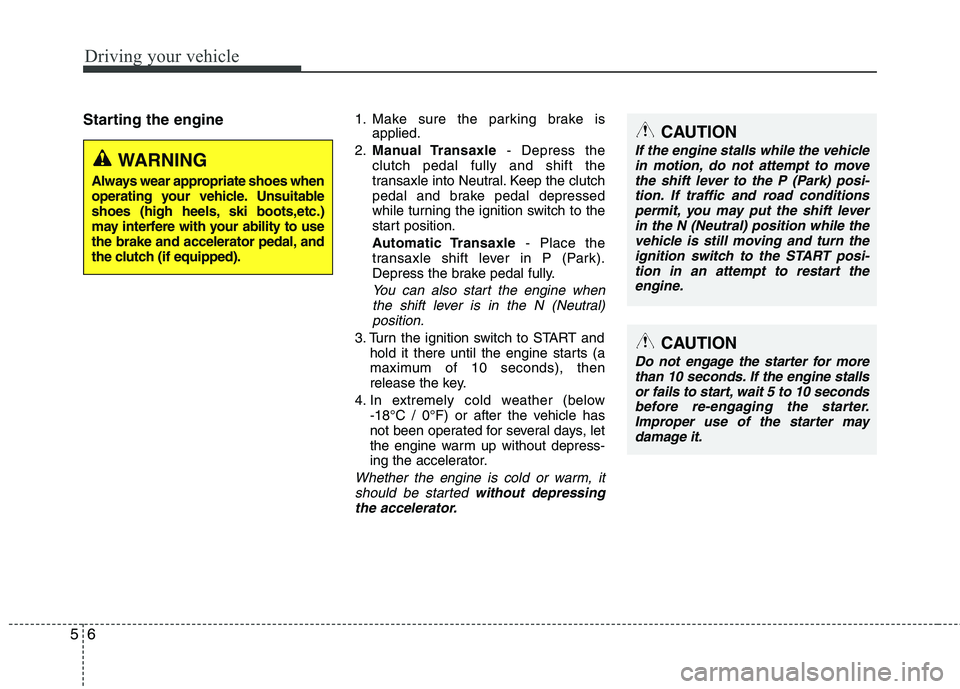
Driving your vehicle
6
5
Starting the engine1. Make sure the parking brake is
applied.
2. Manual Transaxle - Depress the
clutch pedal fully and shift the
transaxle into Neutral. Keep the clutch
pedal and brake pedal depressed
while turning the ignition switch to the
start position.
Automatic Transaxle - Place the
transaxle shift lever in P (Park).
Depress the brake pedal fully.
You can also start the engine when the shift lever is in the N (Neutral)position.
3. Turn the ignition switch to START and hold it there until the engine starts (a
maximum of 10 seconds), then
release the key.
4. In extremely cold weather (below -18°C / 0°F) or after the vehicle has
not been operated for several days, let
the engine warm up without depress-
ing the accelerator.
Whether the engine is cold or warm, itshould be started without depressing
the accelerator.
WARNING
Always wear appropriate shoes when
operating your vehicle. Unsuitable
shoes (high heels, ski boots,etc.)
may interfere with your ability to use
the brake and accelerator pedal, and
the clutch (if equipped).
CAUTION
If the engine stalls while the vehicle in motion, do not attempt to movethe shift lever to the P (Park) posi-tion. If traffic and road conditionspermit, you may put the shift leverin the N (Neutral) position while the vehicle is still moving and turn theignition switch to the START posi- tion in an attempt to restart theengine.
CAUTION
Do not engage the starter for more than 10 seconds. If the engine stallsor fails to start, wait 5 to 10 secondsbefore re-engaging the starter.Improper use of the starter maydamage it.
Page 217 of 382
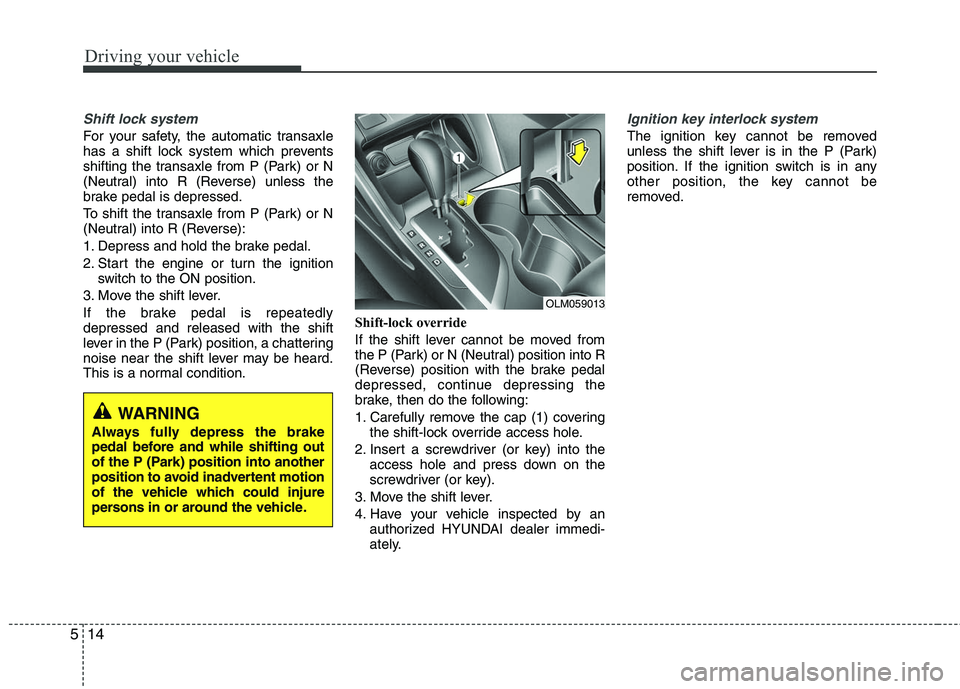
Driving your vehicle
14
5
Shift lock system
For your safety, the automatic transaxle
has a shift lock system which prevents
shifting the transaxle from P (Park) or N
(Neutral) into R (Reverse) unless the
brake pedal is depressed.
To shift the transaxle from P (Park) or N
(Neutral) into R (Reverse):
1. Depress and hold the brake pedal.
2. Start the engine or turn the ignition
switch to the ON position.
3. Move the shift lever.
If the brake pedal is repeatedly
depressed and released with the shift
lever in the P (Park) position, a chattering
noise near the shift lever may be heard.
This is a normal condition. Shift-lock override
If the shift lever cannot be moved from
the P (Park) or N (Neutral) position into R
(Reverse) position with the brake pedal
depressed, continue depressing the
brake, then do the following:
1. Carefully remove the cap (1) covering
the shift-lock override access hole.
2. Insert a screwdriver (or key) into the access hole and press down on the
screwdriver (or key).
3. Move the shift lever.
4. Have your vehicle inspected by an authorized HYUNDAI dealer immedi-
ately.
Ignition key interlock system
The ignition key cannot be removed
unless the shift lever is in the P (Park)
position. If the ignition switch is in any
other position, the key cannot be
removed.
WARNING
Always fully depress the brake
pedal before and while shifting out
of the P (Park) position into another
position to avoid inadvertent motion
of the vehicle which could injure
persons in or around the vehicle.
OLM059013
Page 252 of 382
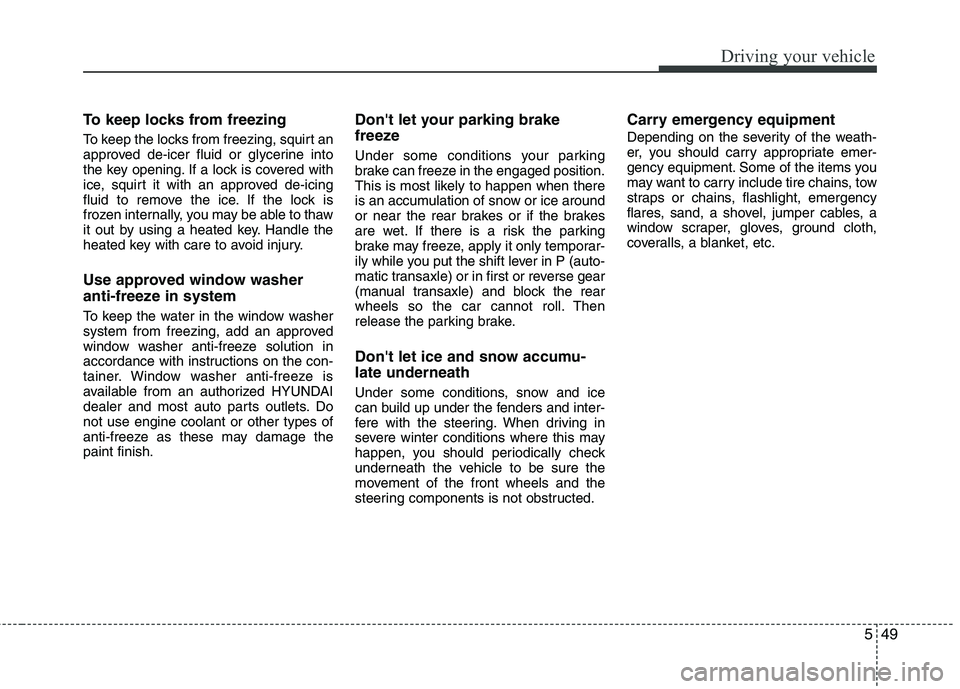
549
Driving your vehicle
To keep locks from freezing
To keep the locks from freezing, squirt an
approved de-icer fluid or glycerine into
the key opening. If a lock is covered with
ice, squirt it with an approved de-icing
fluid to remove the ice. If the lock is
frozen internally, you may be able to thaw
it out by using a heated key. Handle the
heated key with care to avoid injury.
Use approved window washer
anti-freeze in system
To keep the water in the window washer
system from freezing, add an approved
window washer anti-freeze solution in
accordance with instructions on the con-
tainer. Window washer anti-freeze is
available from an authorized HYUNDAI
dealer and most auto parts outlets. Do
not use engine coolant or other types of
anti-freeze as these may damage the
paint finish.
Don't let your parking brake
freeze
Under some conditions your parking
brake can freeze in the engaged position.
This is most likely to happen when there
is an accumulation of snow or ice around
or near the rear brakes or if the brakes
are wet. If there is a risk the parking
brake may freeze, apply it only temporar-
ily while you put the shift lever in P (auto-
matic transaxle) or in first or reverse gear
(manual transaxle) and block the rear
wheels so the car cannot roll. Then
release the parking brake.
Don't let ice and snow accumu-
late underneath
Under some conditions, snow and ice
can build up under the fenders and inter-
fere with the steering. When driving in
severe winter conditions where this may
happen, you should periodically check
underneath the vehicle to be sure the
movement of the front wheels and the
steering components is not obstructed.
Carry emergency equipment
Depending on the severity of the weath-
er, you should carry appropriate emer-
gency equipment. Some of the items you
may want to carry include tire chains, tow
straps or chains, flashlight, emergency
flares, sand, a shovel, jumper cables, a
window scraper, gloves, ground cloth,
coveralls, a blanket, etc.
Page 363 of 382
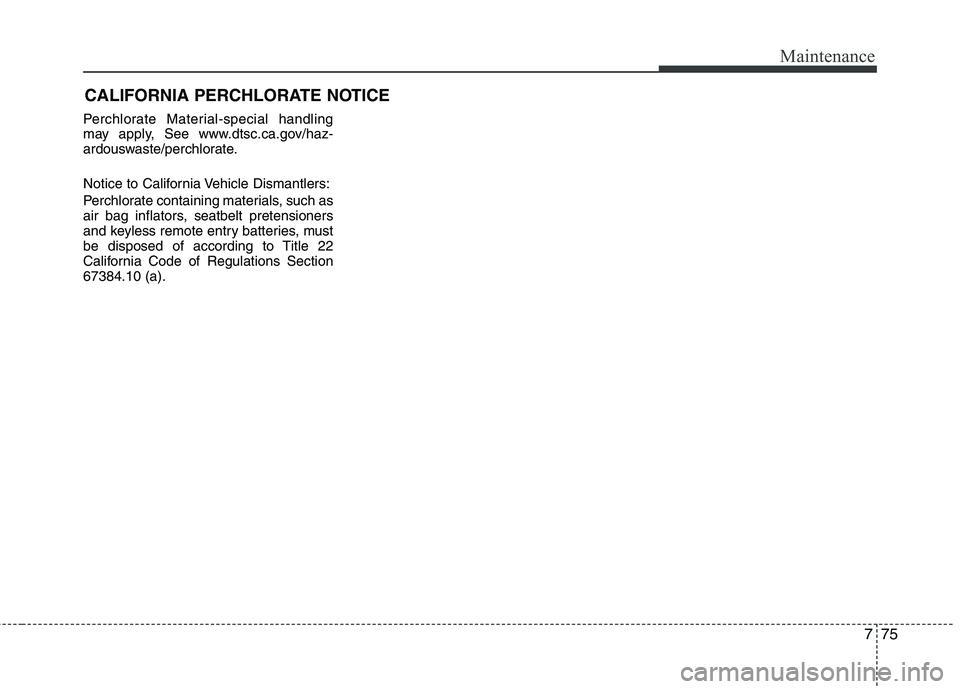
775
Maintenance
CALIFORNIA PERCHLORATE NOTICE
Perchlorate Material-special handling
may apply, See www.dtsc.ca.gov/haz-
ardouswaste/perchlorate.
Notice to California Vehicle Dismantlers:
Perchlorate containing materials, such as
air bag inflators, seatbelt pretensioners
and keyless remote entry batteries, must
be disposed of according to Title 22
California Code of Regulations Section
67384.10 (a).
Page 374 of 382
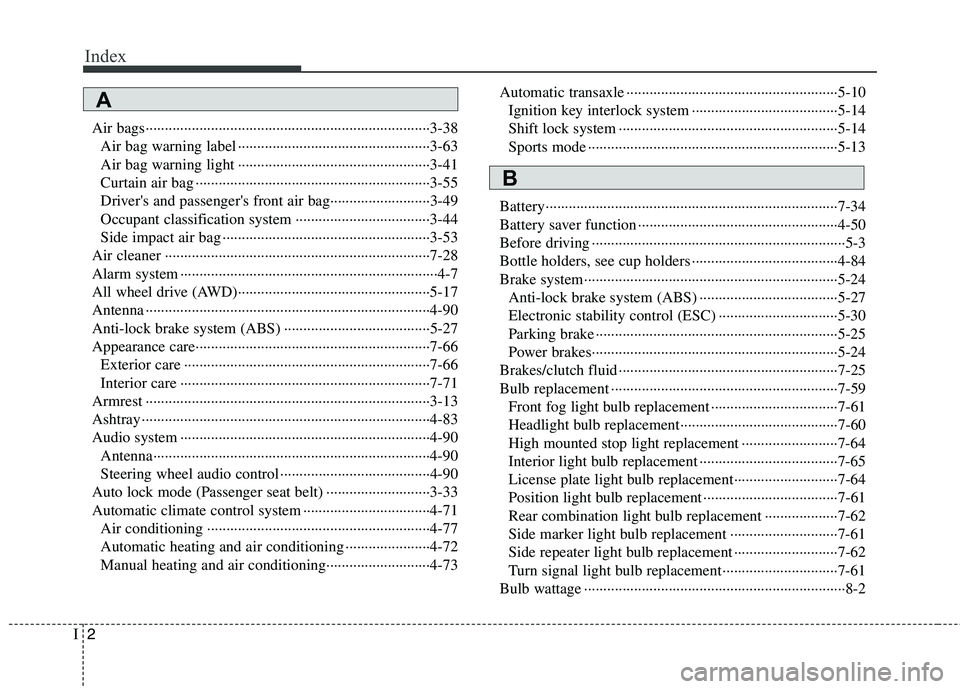
Index
2I
Air bags··················\
··················\
··················\
··················\
··3-38Air bag warning label ··················\
··················\
··············3-63
Air bag warning light ··················\
··················\
··············3-41
Curtain air bag ··················\
··················\
··················\
·······3-55
Driver's and passenger's front air bag··········\
················3-49
Occupant classification system ··················\
·················3-44\
Side impact air bag ··················\
··················\
··················\
3-53
Air cleaner ··················\
··················\
··················\
···············7-28
Alarm system ··················\
··················\
··················\
·············4-7
All wheel drive (AWD)··················\
··················\
··············5-17
Antenna ··················\
··················\
··················\
··················\
··4-90
Anti-lock brake system (ABS) ··················\
··················\
··5-27
Appearance care··················\
··················\
··················\
·······7-66 Exterior care ··················\
··················\
··················\
··········7-66
Interior care ··················\
··················\
··················\
···········7-71
Armrest ··················\
··················\
··················\
··················\
··3-13
Ashtray ··················\
··················\
··················\
··················\
···4-83
Audio system ··················\
··················\
··················\
···········4-90 Antenna··················\
··················\
··················\
··················\
4-90
Steering wheel audio control ··················\
··················\
···4-90
Auto lock mode (Passenger seat belt) ··················\
·········3-33
Automatic climate control system ··················\
···············4-71 Air conditioning ··················\
··················\
··················\
····4-77
Automatic heating and air conditioning ··················\
····4-72
Manual heating and air conditioning··················\
·········4-73 Automatic transaxle ··················\
··················\
··················\
·5-10
Ignition key interlock system ··················\
··················\
··5-14
Shift lock system ··················\
··················\
··················\
···5-14
Sports mode ··················\
··················\
··················\
···········5-13
Battery··················\
··················\
··················\
··················\
····7-34
Battery saver function ··················\
··················\
················4-50
Before driving ··················\
··················\
··················\
············5-3
Bottle holders, see cup holders ··················\
··················\
··4-84
Brake system··················\
··················\
··················\
············5-24 Anti-lock brake system (ABS) ··················\
··················\
5-27
Electronic stability control (ESC) ··················\
·············5-30
Parking brake ··················\
··················\
··················\
·········5-25
Power brakes··················\
··················\
··················\
··········5-24
Brakes/clutch fluid ··················\
··················\
··················\
···7-25
Bulb replacement ··················\
··················\
··················\
·····7-59 Front fog light bulb replacement ··················\
···············7-61
Headlight bulb replacement··················\
··················\
·····7-60
High mounted stop light replacement ··················\
·······7-64
Interior light bulb replacement ··················\
··················\
7-65
License plate light bulb replacement··················\
·········7-64
Position light bulb replacement ··················\
·················7-61\
Rear combination light bulb replacement ··················\
·7-62
Side marker light bulb replacement ··················\
··········7-61
Side repeater light bulb replacement ··················\
·········7-62
Turn signal light bulb replacement··················\
············7-61
Bulb wattage ··················\
··················\
··················\
··············8-2
A
B
Page 377 of 382
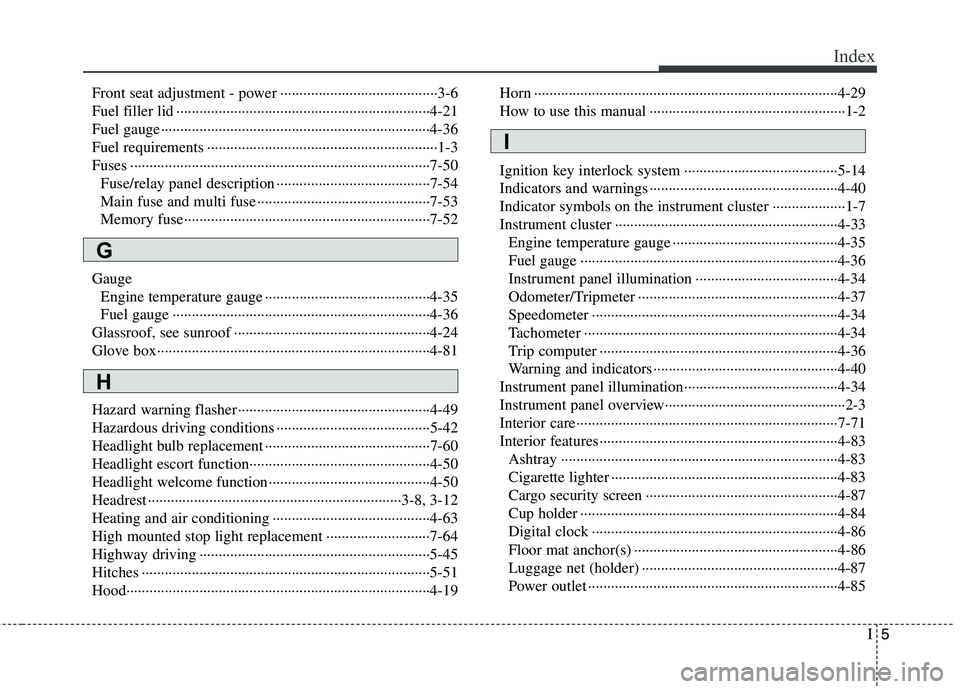
I5
Index
Front seat adjustment - power ··················\
··················\
·····3-6
Fuel filler lid ··················\
··················\
··················\
············4-21
Fuel gauge··················\
··················\
··················\
················4-36
Fuel requirements ··················\
··················\
··················\
······1-3
Fuses ··················\
··················\
··················\
··················\
······7-50Fuse/relay panel description ··················\
··················\
····7-54
Main fuse and multi fuse ··················\
··················\
·········7-53
Memory fuse··················\
··················\
··················\
··········7-52
Gauge Engine temperature gauge ··················\
··················\
·······4-35
Fuel gauge ··················\
··················\
··················\
·············4-36
Glassroof, see sunroof ··················\
··················\
···············4-24
Glove box··················\
··················\
··················\
·················4-81\
Hazard warning flasher ··················\
··················\
··············4-49
Hazardous driving conditions ··················\
··················\
····5-42
Headlight bulb replacement ··················\
··················\
·······7-60
Headlight escort function··················\
··················\
···········4-50
Headlight welcome function··················\
··················\
······4-50
Headrest ··················\
··················\
··················\
············3-8, 3-12
Heating and air conditioning ··················\
··················\
·····4-63
High mounted stop light replacement ··················\
·········7-64
Highway driving ··················\
··················\
··················\
······5-45
Hitches ··················\
··················\
··················\
··················\
···5-51
Hood··················\
··················\
··················\
··················\
·······4-19 Horn ··················\
··················\
··················\
··················\
·······4-29
How to use this manual ··················\
··················\
···············1-2
Ignition key interlock system ··················\
··················\
····5-14
Indicators and warnings ··················\
··················\
·············4-40
Indicator symbols on the instrument cluster ··················\
·1-7
Instrument cluster ··················\
··················\
··················\
····4-33
Engine temperature gauge ··················\
··················\
·······4-35
Fuel gauge ··················\
··················\
··················\
·············4-36
Instrument panel illumination ··················\
··················\
·4-34
Odometer/Tripmeter ··················\
··················\
················4-37
Speedometer ··················\
··················\
··················\
··········4-34
Tachometer ··················\
··················\
··················\
············4-34
Trip computer ··················\
··················\
··················\
········4-36
Warning and indicators ··················\
··················\
············4-40
Instrument panel illumination··················\
··················\
····4-34
Instrument panel overview··················\
··················\
···········2-3
Interior care··················\
··················\
··················\
··············7-71
Interior features··················\
··················\
··················\
········4-83 Ashtray ··················\
··················\
··················\
··················\
4-83
Cigarette lighter ··················\
··················\
··················\
·····4-83
Cargo security screen ··················\
··················\
··············4-87
Cup holder ··················\
··················\
··················\
·············4-84
Digital clock ··················\
··················\
··················\
··········4-86
Floor mat anchor(s) ··················\
··················\
·················4-86\
Luggage net (holder) ··················\
··················\
···············4-87
Power outlet ··················\
··················\
··················\
···········4-85
G
I
H